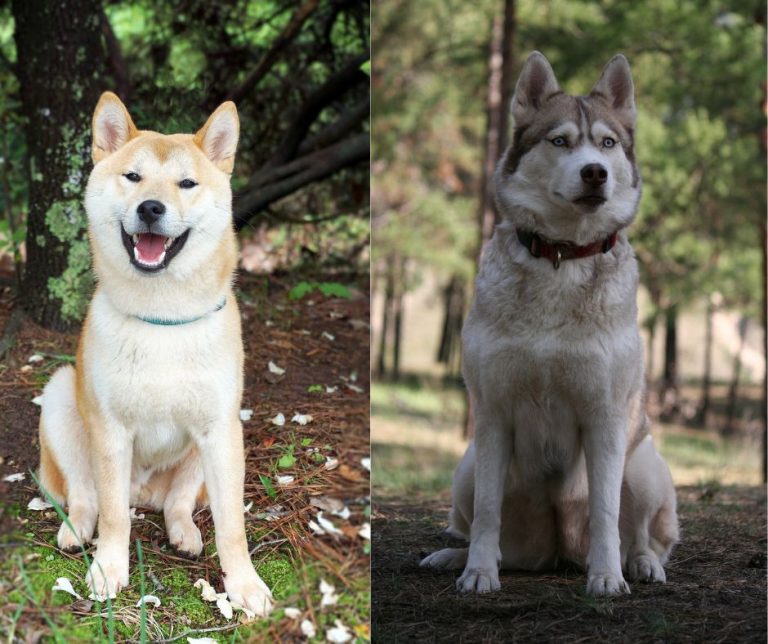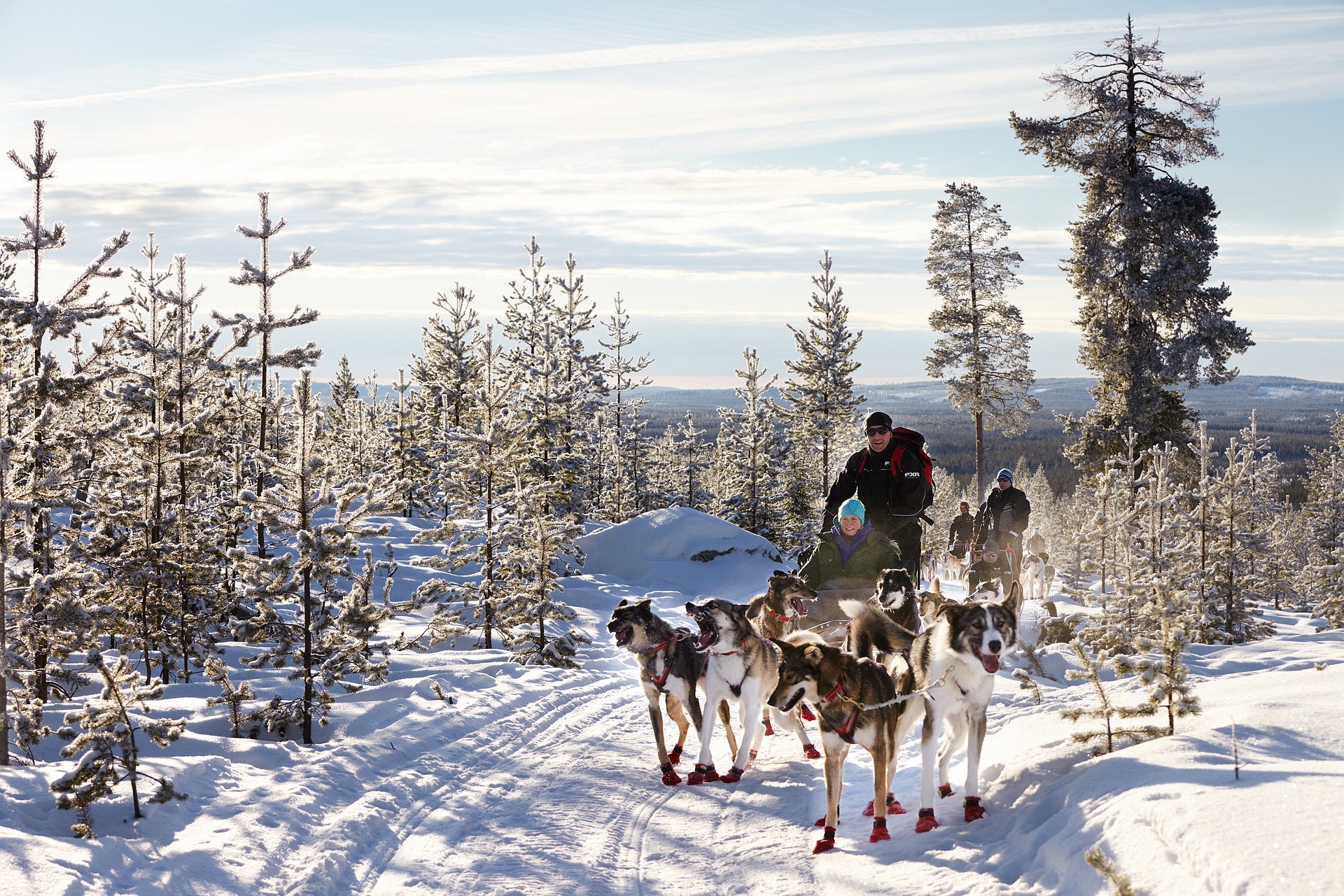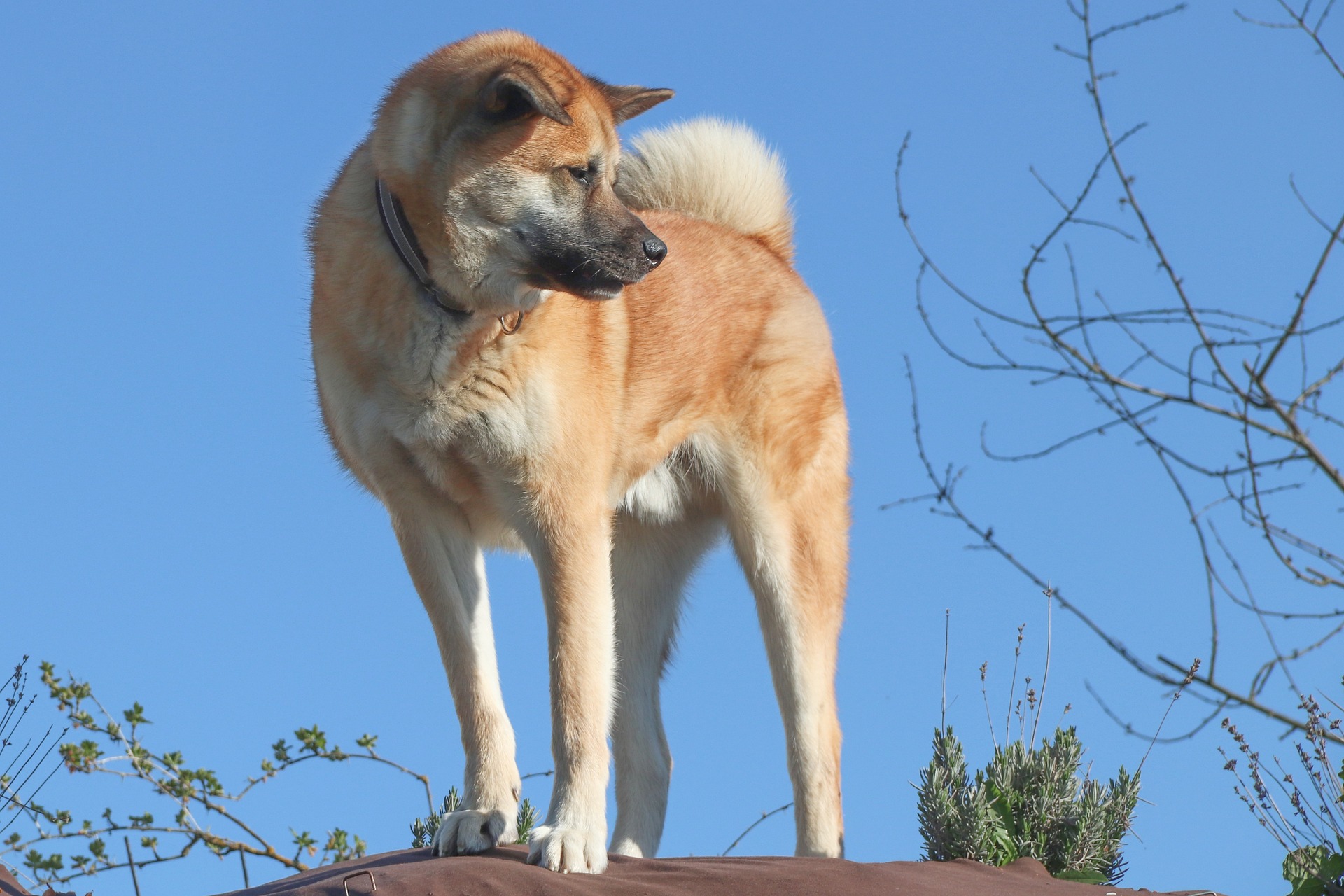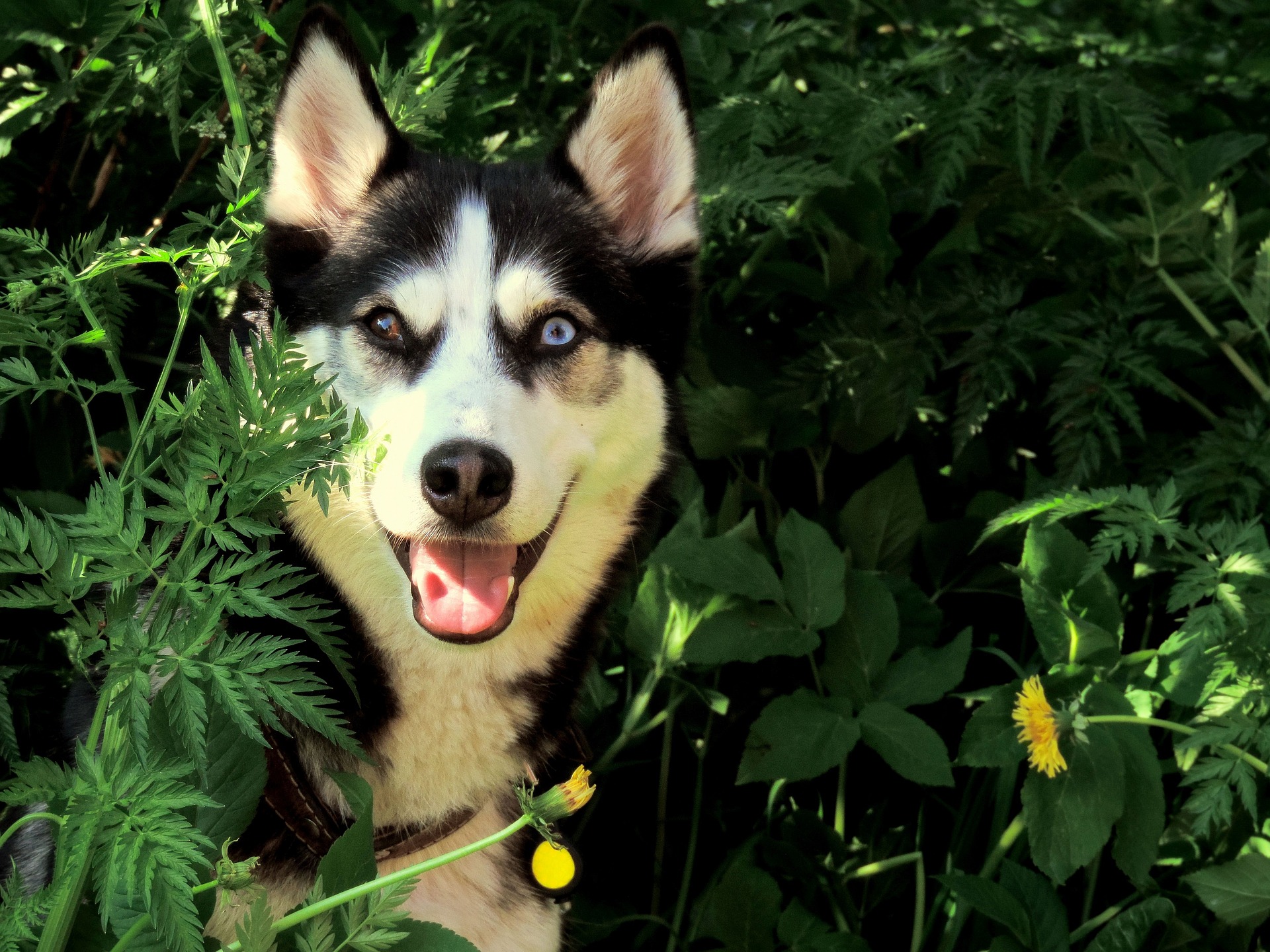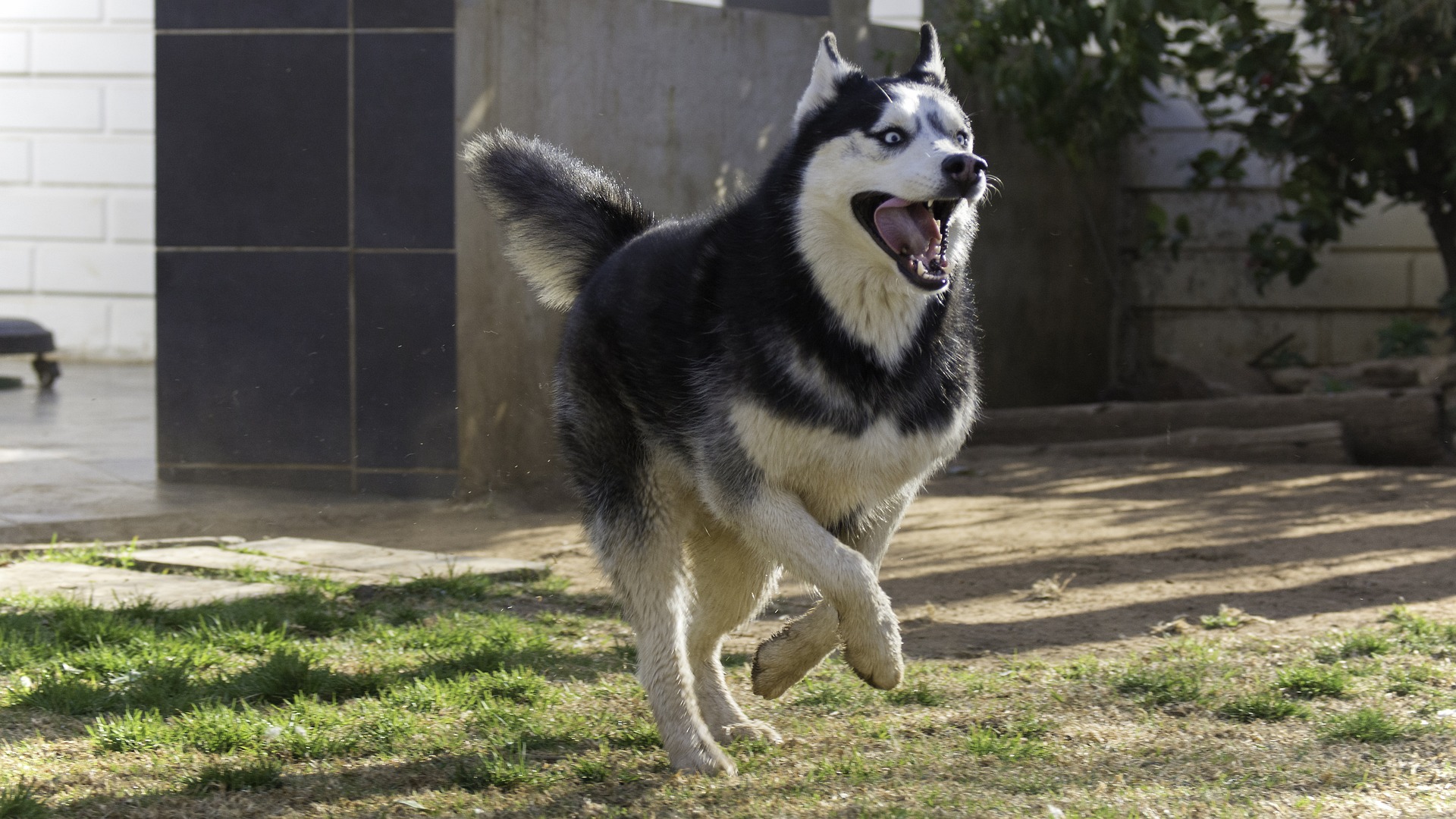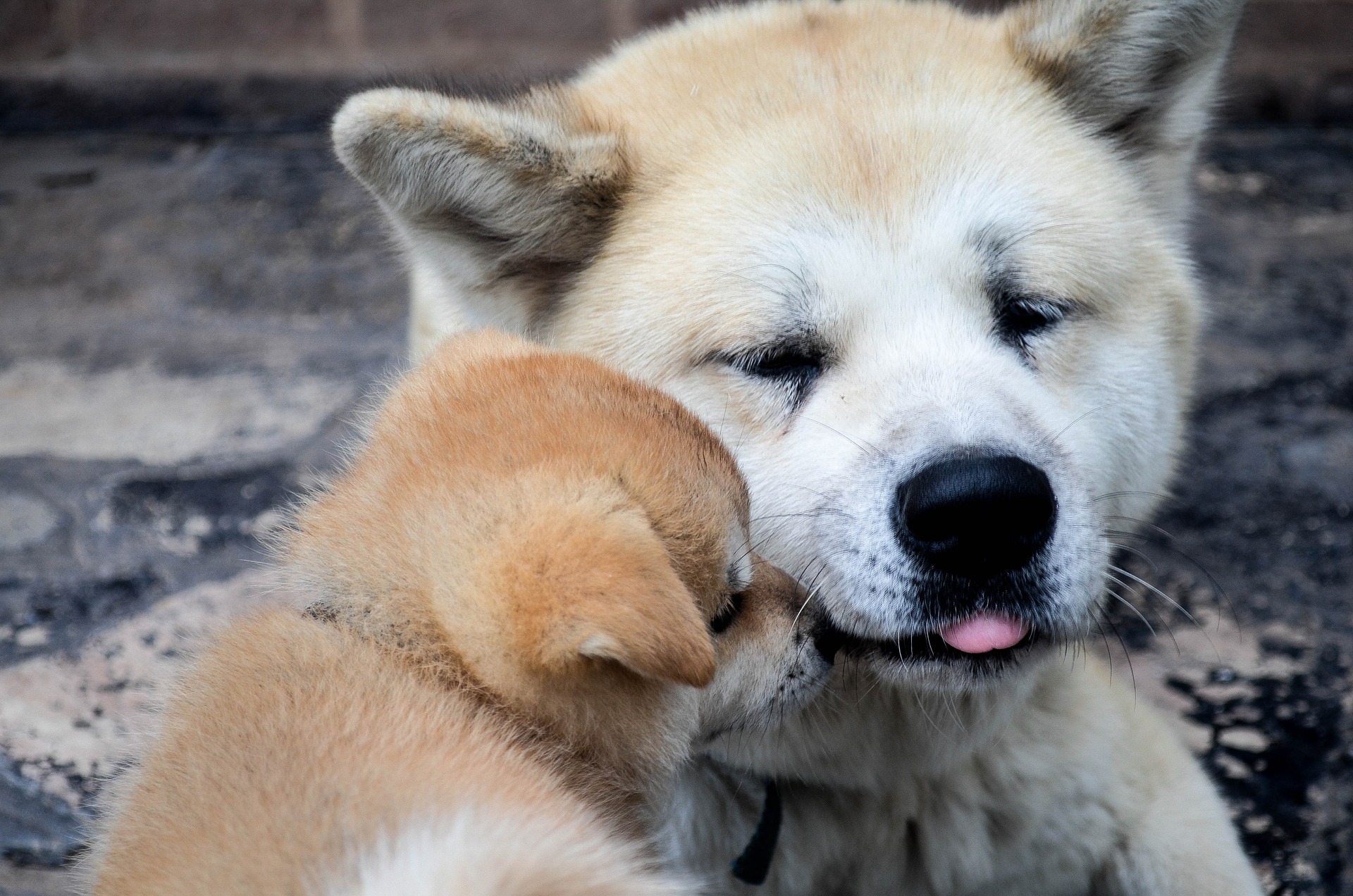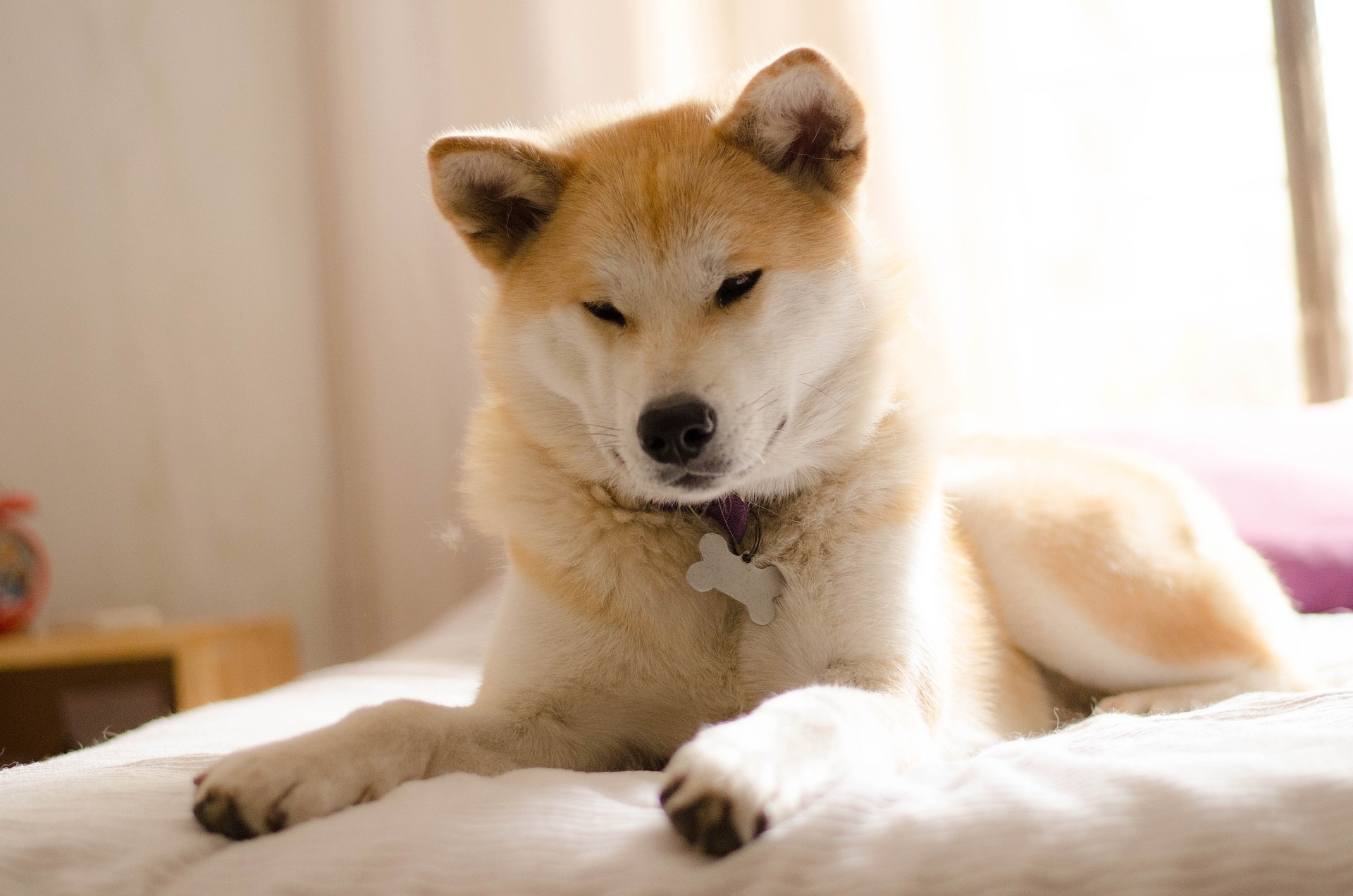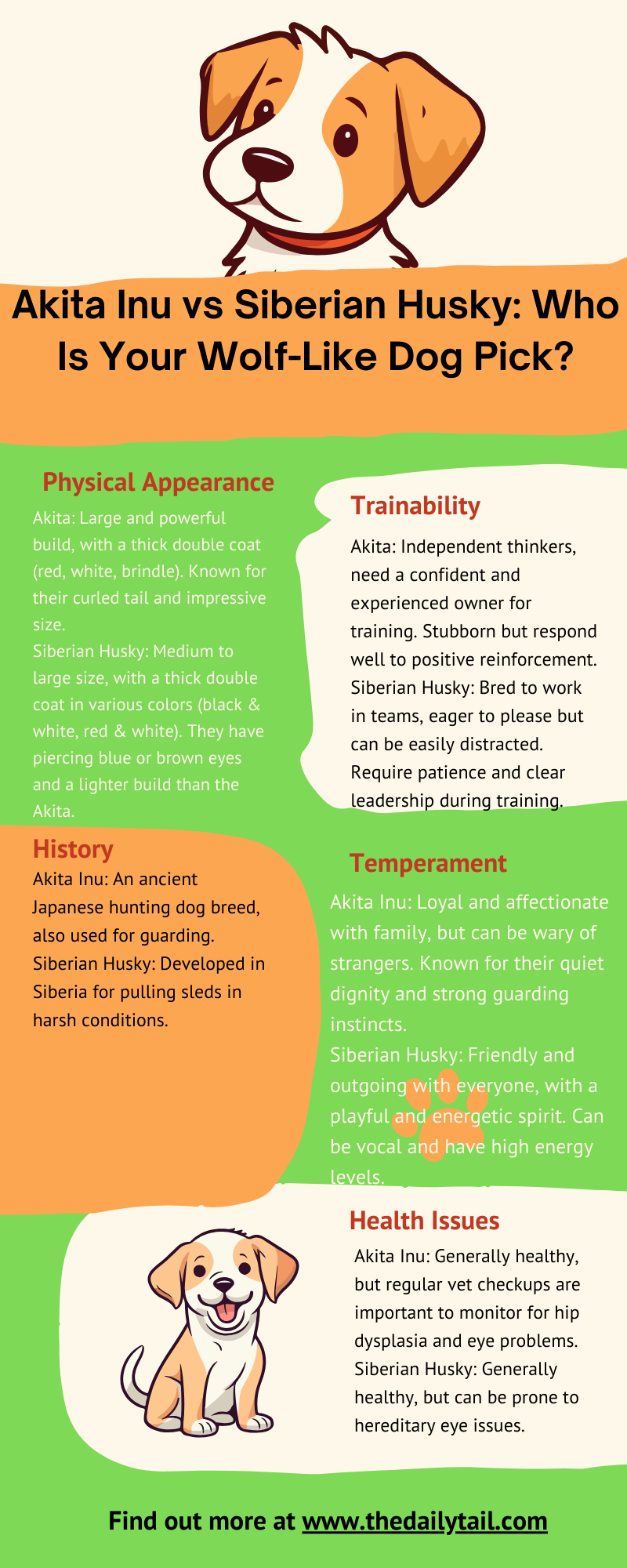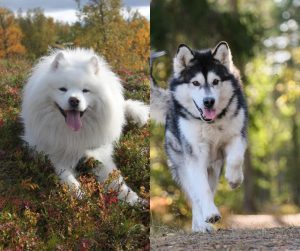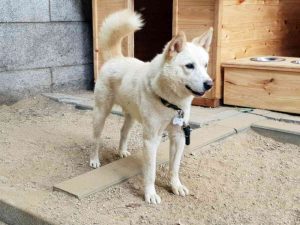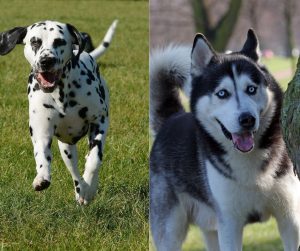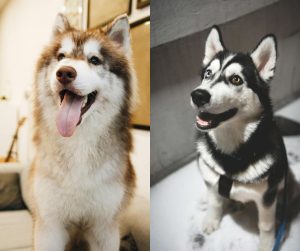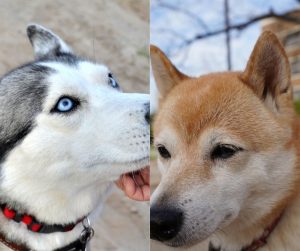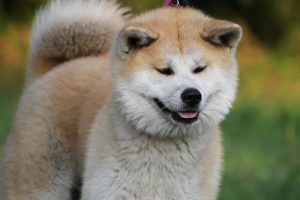When considering a loyal and striking canine companion, two breeds often come to mind: the Akita Inu and the Siberian Husky. Both have roots steeped in history and culture, with the Akita originating from the mountains of Japan and the Siberian Husky from the icy expanses of northeastern Asia.
These breeds not only boast distinctive looks but also unique personalities that have captivated dog lovers worldwide.
Their physical characteristics are easily recognizable, with the Akita Inu being robust and large with a bear-like head, while the Siberian Husky is sleeker with wolf-like features. These dogs similarly carry a dignified yet mischievous demeanor, making them both admired and challenging to prospective owners.
Deeply exploring each dog breed uncovers the nuances in their temperaments, exercise needs, and overall health, which are crucial for anyone considering adding these dogs to their family. Let’s talk more about the Japanese Akita Inu vs Siberian Husky dog breed comparison.
Key Takeaways
- Akitas and Huskies are loyal breeds with historical significance from Japan and northeastern Asia, respectively
- They possess distinctive physical attributes, Akitas being larger and bear-like, and Huskies sleek with wolf-like features
- Understanding their unique personalities, exercise requirements, and health is key when choosing to bring one into your home
Breed Origins and History
Exploring the rich histories of the Akita Inu and the Siberian Husky unveils a tapestry of cultural significance and functional breeding that is as fascinating as the breeds themselves.
Akita Inu History
The Akita Inu is deeply rooted in the history of Japan, where it is considered a national treasure. This breed originated from the Akita region, and it was originally bred for hunting large game such as wild boar, deer, and even bears. The Akita’s lineage dates back centuries and it has been revered for its loyalty and courage. The Akita is closely related to the Shiba Inu dog breed, which some people consider it to be a smaller version of the Akita.
One notable figure who became enamored with the Akita’s demeanor was Helen Keller, who introduced the breed to American shores after being gifted one during her visit to Japan.
We have to note that the Akita dog breed has traveled across the Atlantic Ocean. And since then, people have begun making a difference between a Japanese Akita and American Akita.
Siberian Husky History
The Siberian Husky dog breed’s story, on the other hand, starts with the Chukchi people of northeastern Asia. These indomitable dogs were bred not for hunting, but as a sled dog capable of enduring the harsh conditions of the Siberian Arctic. The Husky’s role was critical, as it enabled Chukchi communities to expand their hunting grounds.
Siberian Huskies became renowned worldwide when, in 1925, they played a key role in the delivery of diphtheria serum across Nome, Alaska, during an outbreak, demonstrating their incredible endurance and work ethic. Nowadays, many people think of the Siberian Husky puppy as the closest relative to the wolf. Akitas, on the other hand, have a more fox-like appearance.
Physical Characteristics
When choosing between an Akita Inu and a Siberian Husky, physical traits play a significant role. Understanding their size, coat, and markings will better equip potential owners to make the right choice aligned with their preferences and lifestyle. Let’s take a look at the breed standard set by the American Kennel Club.
Size Comparison
The Akita Inu and Siberian Husky have notable differences in size. An adult Akita typically stands taller and outweighs the Siberian Husky.
- Akita Inu:
- Height: 24-28 inches
- Weight: 70-130 pounds
- Siberian Husky:
- Height: 20-23.5 inches
- Weight: 35-65 pounds
Their size difference is not just a matter of a few pounds; Akitas are often double the weight of Huskies, which is significant when considering the space and exercise they’ll need.
Coat and Markings
Both breeds sport a double coat that offers protection against harsh weather, but their fur and markings set them apart.
- Akita Inu:
- Fur: Thick and soft undercoat with a harsh, straight outer coat
- Markings: Colors range from white to brindle and pinto. Facial markings, like the ‘urajiro’ (cream to white coloring on the sides of the muzzle, cheeks, underside of the jaw, neck, chest, body, and tail), are distinctive
- Siberian Husky:
- Fur: Dense and fluffy, with an equally thick underlayer and a smooth outer coat
- Markings: Known for their striking masks and a variety of color patterns, including black, grey, red, and agouti. They often have blue or multicolored eyes, adding to their appealing appearance
In conversation, you’ll often hear Husky owners chatting about the daily fluff on their floors—a testament to their constant shedding. Akitas, while no strangers to shedding themselves, typically blow their coat seasonally. Both breeds require regular grooming, but the routine can be a pleasant bonding experience rather than a chore.
Personality and Temperament
When choosing between an Akita Inu vs Siberian Husky, understanding their distinct personalities is crucial. Each breed has unique characteristics that define how they interact with their family and the world around them.
Behavioral Traits
Akita Inu:
- Independence: Often described as cat-like in their independence, Akitas can entertain themselves but remain loyal to their family
- Stubbornness: Their independence can sometimes manifest as stubbornness, which may make training a challenge
- Protective Nature: This breed is well-known for being protective, making them excellent watchdogs for the home
Siberian Husky:
- Energetic: Huskies are incredibly energetic, requiring a lot of exercise and stimulation
- Sociable: Unlike Akitas, who can be aloof, Huskies generally love being the center of attention
- Less Dominant: They tend to have a less dominant personality, which can sometimes make them more manageable in a family setting
Sociability with Family and Strangers
Akita Inu:
- Family Loyalty: Akitas form strong bonds and are deeply loyal to their family members, often creating a lasting attachment to their owners
- Reserved with Strangers: Typically, they are reserved around strangers, which can be misinterpreted as being unfriendly, but it’s their protective instinct at play
Siberian Husky:
- Family Affection: Huskies are known for their affectionate and loving nature with their family, including children
- Friendly with Strangers: They are usually gregarious and friendly even with strangers, which makes them less suitable as guard dogs but great as family pets
Exercise and Training Needs
When considering the exercise and training needs of Akita Inus versus Siberian Huskies, one must understand that both breeds possess a high level of energy and require not just physical activity but also mental stimulation. They each come with distinct challenges that are essential to their happiness and health. We have to remember, Huskies were once used as a sled dog. Because of that, even nowadays, they need rigorous exercise and mental stimulation.
Physical Activity Requirements
Akita Inus and Siberian Huskies are not just energetic; they thrive on regular, rigorous exercise to keep them in top shape. A sedentary lifestyle doesn’t suit these breeds—they need to move!
- Akita Inu: Daily exercise is a must. They benefit from activities like long walks, jogging, playing fetch, and interactive games that can provide both physical engagement and mental challenges
- Siberian Husky: These dogs come with a very high energy level; they adore endurance activities. Huskies excel in running, hiking, and even dog sports like agility. They also love to pull, so activities like sled pulling or skijoring can be a perfect fit
Obedience and Training Challenges
With Akitas and Huskies, sharp minds come with strong wills. While they are capable of learning a myriad of commands, their independent nature can present unique training challenges.
- Akita Inu: Known for their intelligence, Akitas can sometimes be willful, making obedience training a test of consistency and patience. They respond well to positive reinforcement and require early socialization and training to manage their protective nature
- Siberian Husky: Huskies may be mischievous and display a more free-spirited attitude towards training. They soak up obedience training when it’s kept fun and engaging. Consistency is key, along with a gentle but firm hand to guide them
Health and Lifespan
When it comes to choosing a furry companion, understanding their health and how long they’ll be part of the family are important factors. Akitas and Siberian Huskies bring joy to households, but they do have different health concerns and life expectancies.
Common Health Concerns
Akitas:
- Hip Dysplasia: A genetic condition causing abnormal formation in the hip joint
- Progressive Retinal Atrophy: A degenerative eye disorder that can lead to blindness
- Bloat: A life-threatening condition where the stomach twists after filling with air
Siberian Huskies:
- Cataracts: A common issue where the lens of the eye becomes opaque, impairing vision
- Hip Dysplasia
- Progressive Retinal Atrophy
Both dog breeds require regular check-ups with a vet to catch these conditions early. A little tenderness and care can go a long way in managing their health.
Expected Longevity
Akitas generally have a lifespan of 10-13 years. They tend to be robust dogs, but their larger size can also mean a shorter life compared to smaller breeds. This Japanese breed is among the longer-living large dog breeds.
Siberian Huskies might be on the active side with a lifespan often ranging between 12-14 years. With their zest for life, they can often maintain good health for much of their lifespan.
Remember, every dog is an individual.
Plenty of exercise, a proper diet, and lots of love can do wonders for their well-being. Nowadays, breeders also try to mix these two with a smaller dog to get a healthier variation.
Grooming and Maintenance
When it comes to keeping both the Akita and the Siberian Husky looking their best, dog parents will need to prioritize grooming and maintenance. It’s not just for good looks—regular care keeps them comfortable and healthy, too.
Shedding and Coat Care
Akita Inu:
- They’re known for their dense double coat which sheds heavily, especially during seasonal changes
- Weekly brushing is essential to manage shedding and keep their coat in tip-top condition
Siberian Husky:
- Huskies also have a double layer coat prone to shedding
- More frequent brushing, up to several times a week, can help control the amount of hair left around the house
Shedding seasons require extra attention for both breeds.
A de-shedding tool can be particularly useful during these times to remove loose fur and prevent mats.
General Upkeep
Akita Inu:
- They benefit from regular baths, but not so often that you risk drying out their skin
- Keep an eye on their nails and trim them regularly to prevent any discomfort during walks
Siberian Husky:
- Huskies may need bathing less frequently unless they find something particularly messy to get into
- Like the Akita, they need their nails trimmed regularly. Neglecting this can lead to painful walking and posture issues
Both breeds will appreciate grooming as part of their routine.
It’s a chance for physical maintenance, sure, but also a momento for bonding and checking on their overall well-being.
Compatibility with Lifestyle
Before deciding on an Akita Inu or a Siberian Husky, potential dog owners should consider how each breed fits into their lifestyle. The two breeds have distinctive needs and personalities that will greatly influence family dynamics, living spaces, and social interactions.
Living Environment Preferences
Akitas are sturdy and independent dogs that thrive in a home with space to roam, ideally with a secure backyard.
Apartment living can be challenging for an Akita, as they have high energy levels and a robust build; a smaller space might not meet their needs for exercise and exploration.
In contrast, Siberian Huskies are adaptable and can adjust to apartment living with adequate daily exercise. However, they too prefer a house with a yard.
For both breeds, sufficiently fenced surroundings are essential to cater to their active natures and to prevent them from wandering off, as they can be superb escape artists.
Family and Pet Relations
When it comes to family life, the sociable and friendly demeanor of Siberian Huskies makes them a joy for families, including those with children.
Their energetic personalities are well-suited to an active family that enjoys outdoor adventures.
Huskies are typically social with other dogs as well, making them great companions for homes with multiple pets.
Akitas possess a more reserved personality, showing deep loyalty to their families but can be wary of strangers.
They’re known to be excellent guardians of their home.
Early socialization is key to raising a well-rounded Akita who can interact with the family and other pets peacefully.
Akitas may be better suited as the sole pet and may require more attention to become a harmonious family pet, especially around young children.
Understanding Breed Differences
When choosing between an Akita Inu vs Siberian Husky, potential dog owners should consider their distinct traits and how these will align with their lifestyle and preferences.
Akita vs Siberian Husky Traits
Akita Inu
- Height: 24-28 inches
- Weight: 70-130 pounds
- Temperament: Independent, protective, loyal
- Energy Levels: Lower than Huskies but still require regular exercise
- Longevity: 10-13 years
Traits Overview: Akitas are large, powerful dogs with a protective nature and are often more reserved. They can be strong-willed and may require an owner who understands how to work with such traits. Their loyalty is unwavering, often forming a deep bond with their family and becoming excellent watch dogs. An Akita’s intelligence is high, but so is their need to be properly socialized to prevent aggression.
Siberian Husky
- Height: 20-23.5 inches
- Weight: 35-65 pounds
- Temperament: Mischievous, energetic, affectionate
- Energy Levels: Very high; loves running and playing
- Longevity: 12-14 years
Traits Overview: Siberian Huskies are known for their enthusiastic and loving personalities. They are highly energetic, requiring lots of exercise and space to run. When properly socialized, they are friendly and less protective than Akitas, making them better suited for homes with other pets or children. Huskies are also intelligent and loyal, yet their mischievous nature can pose a challenge for training.
Making the Right Choice
When deciding between these two breeds, it is crucial to consider the differences in energy levels and protective instincts.
Akitas may do better in a less active household that desires a protective dog with a strong presence. Meanwhile, Huskies thrive in a dynamic environment where they can burn off their abundant energy.
Both breeds display loyalty and intelligence, but their approaches to expressing these traits can be as diverse as the dogs themselves. For a family seeking a companion for adventures, the Siberian Husky could be the perfect fit; for those in need of a vigilant guardian, the Akita stands out. Proper training and socialization are key to nurturing a well-adjusted dog, regardless of the breed.

